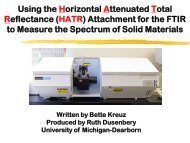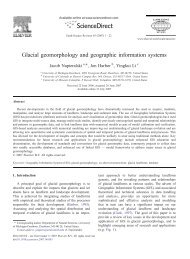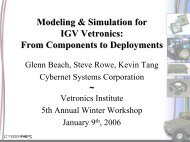- Page 1 and 2:
Introduction to On BoardDiagnostics
- Page 3 and 4:
Introduction to On BoardDiagnostics
- Page 5 and 6:
Introduction to On BoardDiagnostics
- Page 7 and 8:
Introduction to On BoardDiagnostics
- Page 9 and 10:
OBD II monitors more components and
- Page 11 and 12:
Introduction to On BoardDiagnostics
- Page 13 and 14:
Introduction to On BoardDiagnostics
- Page 15 and 16:
Introduction to On BoardDiagnostics
- Page 17 and 18:
___________________________________
- Page 19 and 20:
Introduction to On BoardDiagnostics
- Page 21 and 22:
Introduction to On BoardDiagnostics
- Page 23 and 24:
Introduction to On BoardDiagnostics
- Page 25 and 26:
Powertrain and EmissionControls in
- Page 27 and 28:
Powertrain and EmissionControls in
- Page 29 and 30:
Powertrain and EmissionControls in
- Page 31 and 32:
Powertrain and EmissionControls in
- Page 33 and 34:
Powertrain and EmissionControl in P
- Page 35 and 36:
Powertrain and EmissionControls in
- Page 37 and 38:
Powertrain and EmissionControls in
- Page 39 and 40:
OBD II for L & MD VehiclesSTD Manua
- Page 41 and 42:
OBD II for L & MD VehiclesSTD Manua
- Page 43 and 44:
OBD II for L & MD VehiclesSTD Manua
- Page 45 and 46:
OBD II for L & MD VehiclesDiagnosti
- Page 47 and 48:
OBD II for L & MD VehiclesSTD Manua
- Page 49 and 50:
OBD II for L & MD VehiclesSTD Manua
- Page 51 and 52:
OBD II for L & MD VehiclesSTD Manua
- Page 53 and 54:
OBD II for L & MD VehiclesSTD Manua
- Page 55 and 56:
OBD II for L & MD VehiclesSTD Manua
- Page 57 and 58:
OBD II for L & MD VehiclesSTD Manua
- Page 59 and 60:
Fundamentals of PowertrainControl s
- Page 61 and 62:
The Freeze Frame can also be used f
- Page 63 and 64:
Fundamentals of PowertrainControl s
- Page 65 and 66:
Evaporative System Monitoring: Hydr
- Page 67 and 68:
OBD(II)In addition the electrical c
- Page 69 and 70:
Fundamentals of PowertrainControl s
- Page 71 and 72:
Fundamentals of PowertrainControl s
- Page 73 and 74:
Fundamentals of PowertrainControl s
- Page 75 and 76:
Fundamentals of PowertrainControl s
- Page 77 and 78:
Fundamentals of PowertrainControl s
- Page 79 and 80:
Fundamentals of PowertrainControl s
- Page 81 and 82: Fundamentals of PowertrainControl s
- Page 83 and 84: Fundamentals of PowertrainControl s
- Page 85 and 86: Fundamentals of PowertrainControl s
- Page 87 and 88: Fundamentals of PowertrainControl s
- Page 89 and 90: Fundamentals of PowertrainControl s
- Page 91 and 92: Fundamentals of PowertrainControl s
- Page 93 and 94: Fundamentals of PowertrainControl s
- Page 95 and 96: Fundamentals of PowertrainControl s
- Page 97 and 98: Fundamentals of PowertrainControl s
- Page 99 and 100: Fundamentals of PowertrainControl s
- Page 101 and 102: Fundamentals of PowertrainControl s
- Page 103 and 104: Sensors and ActuatorsEmployed in OB
- Page 105 and 106: Sensors and ActuatorsEmployed in OB
- Page 107 and 108: Sensors and ActuatorsEmployed in OB
- Page 109 and 110: Sensors and ActuatorsEmployed in OB
- Page 111 and 112: Sensors and ActuatorsEmployed in OB
- Page 113 and 114: Sensors and ActuatorsEmployed in OB
- Page 115 and 116: Sensors and ActuatorsEmployed in OB
- Page 117 and 118: Sensors and ActuatorsKnock sensorEm
- Page 119 and 120: Sensors and ActuatorsEmployed in OB
- Page 121 and 122: Sensors and ActuatorsEmployed in OB
- Page 123 and 124: Secondary air valvesSensors and Act
- Page 125 and 126: Sensors and ActuatorsEmployed in OB
- Page 127 and 128: Functionality of PowertrainControl
- Page 129 and 130: Functionality of PowertrainControl
- Page 131: Functionality of PowertrainControl
- Page 135 and 136: Functionality of PowertrainControl
- Page 137 and 138: Functionality of PowertrainControl
- Page 139 and 140: Functionality of PowertrainControl
- Page 141 and 142: Functionality of PowertrainControl
- Page 143 and 144: Functionality of PowertrainControl
- Page 145 and 146: Functionality of PowertrainControl
- Page 147 and 148: Functionality of PowertrainControl
















